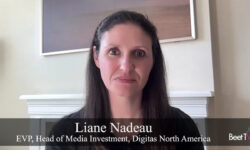As consumers seek more control over how their personal data are shared with brands, marketers are returning to contextual advertising – or placing ads next to content that’s most likely to engage a target audience. This shift is occurring as advances in artificial intelligence fortify contextual signals.
“Contextual AI can help influence consumer behavior in a couple of different ways,” Clarissa Season, chief experience officer at Omnicom Group’s Annalect, said in this interview with Lisa Granatstein, editorial director of Beet.TV.
“First, it can help us to better identify the contexts that are going to make the most sense for our audience,” Season said. “It can also help us to build pieces of creative on the fly that are contextually relevant.”

Generative artificial intelligence technology was popularized by apps such as OpenAI’s ChatGPT, which was designed to quickly generate responses to questions written in everyday language. Gen AI can also be used to assemble customized imagery for ads, though the process has led to thorny legal disputes over the use of copyrighted material to train AI algorithms.
“We don’t fully understand all the laws related to AI,” Season said. “Assembling creative that you’ve produced outside an AI context is completely legal, but if you’re starting to have images generated on the fly, that starts to become potentially problematic.”
Some advertisers are hesitant to use gen AI unless it’s clear that they aren’t infringing the intellectual property rights of creators or the owners of creative works.
“You want to understand the laws and the ethics behind what you’re doing, but I think as you jump into it, you want to keep the consumer at the front of your mind,” Season said, “because if we are not doing something that’s going to ultimately benefit the consumer, we’re just doing something cool because it’s cool.”
You’re watching “The Power of Context: Driving Attention to Intention in a Privacy-First Era,” a Beet.TV Leadership Series, presented by Seedtag. For more videos from this series, please visit this page.





































